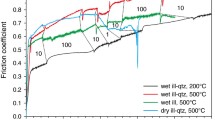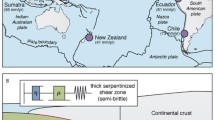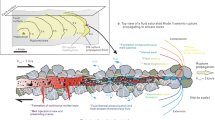Abstract
Sustained slow slip, which is a distinctive feature of slow slip events (SSEs), is investigated theoretically, assuming a fault embedded within a fluid-saturated 1D thermo-poro-elastic medium. The object of study is specifically SSEs occurring at the down-dip edge of seismogenic zone in hot subduction zones, where mineral dehydrations (antigorite, lawsonite, chlorite, and glaucophane) are expected to occur near locations where deep slow slip events are observed. In the modeling, we introduce dehydration reactions, coupled with slip-induced dilatancy and thermal pressurization, and slip evolution is assumed to interact with fluid pressure change through Coulomb’s frictional stress. Our calculations show that sustained slow slip events occur when the dehydration reaction is coupled with slip-induced dilatancy. Specifically, slow slip is favored by a low initial stress drop, an initial temperature of the medium close to that of the dehydration reaction equilibrium temperature, a low permeability, and overall negative volume change associated with the reaction (i.e., void space created by the reaction larger than the space occupied by the fluid released). Importantly, if we do not assume slip-induced dilatancy, slip is accelerated with time soon after the slip onset even if the dehydration reaction is assumed. This suggests that slow slip is sustained for a long time at hot subduction zones because dehydration reaction is coupled with slip-induced dilatancy. Such slip-induced dilatancy may occur at the down-dip edge of seismogenic zone at hot subduction zones because of repetitive occurrence of dehydration reaction there.









Similar content being viewed by others
References
Ando R, Takeda N, Yamashita T (2012) Propagation dynamics of seismic and aseismic slip governed by fault heterogeneity and Newtonian rheology. J Geophys Res 117:B11308. doi:10.1029/2012JB009532
Audet P, Bostock MG, Christensen NI, Peacock SM (2009) Seismic evidence for overpressured subducted oceanic crust and megathrust fault sealing. Nature 457:76–78
Beeler NM, Thomas A, Burgmann R, Shelly D (2013) Inferring fault rheology from low-frequency earthquakes on the San Andreas. J Geophys Res 118:5976–5990. doi:10.1002/2013JB010118
Biot MA (1956) Theory of propagation of elastic waves in a fluid saturated porous solid. I—low-frequency range. J Acoust Soc Am 28:168–178
Brace WF (1980) Permeability of crystalline and argillaceous rocks. Int J Rock Mech Min Sci and Geomech Abstr 17:241–251
Brantut N, Schubnel A, Rouzaud J-N, Brunet F, Shimamoto T (2008) High velocity frictional properties of a clay bearing fault gouge and implications of earthquake mechanics. J Geophys Res 113:B14401. doi:10.1029/2007JB005551
Brantut N, Schubnel A, Corvisier J, Sarout J (2010) Thermochemical pressurization of faults during coseismic slip. J Geophys Res 115:B05314. doi:10.1029/2009JB006533
Brantut N, Sulem J, Schubnel A (2011a) Effect of dehydration reactions on earthquake nucleation: stable sliding, slow transients, and unstable slip. J Geophys Res 116:B05304. doi:10.1029/2010JB007876
Brantut N, Han R, Findling N, Shimamoto T, Schubnel A (2011b) Fast slip with inhibited temperature rise due to mineral dehydration: evidence from experiments on gypsum. Geology 39:59–62
Brown JR, Beroza GC, Ide S, Ohta K, Shelly DR, Schwartz SY, Rabbel W, Thorwart M, Kao H (2009) Deep low-frequency earthquakes in tremor localize to the plate interface in multiple subduction zones. Geophys Res Lett 36:L19306. doi:10.1029/2009GL040027
Chester FM (1994) Effects of temperature on friction: constitutive equations and experiments with quartz gauge. J Geophys Res 99:7247–7261. doi:10.1029/93JB03110
Christensen NI (1984) Pore pressure and oceanic crustal seismic structure. Geophys J R Astron Soc 79:411–423
Connolly JAD (1990) Multivariable phase diagrams: An algorithm based on generalized thermodynamics. Am J Sci 290:666–718
Connolly JAD (1997) Devolatilization-generated fluid pressure and deformation-propagated fluid flow during prograde regional metamorphism. J Geophys Res 102:18149–18173
Connolly JAD, Podladchikov YY (1998) Compaction-driven fluid flow in viscoelastic rock. Geodin Acta 11:55–84
Criado JM, González M, Málek J, Ortega A (1995) The effect of the CO2 pressure on the thermal decomposition kinetics of calcium carbonate. Themochimica Acta 254:121–127
David C, Wong T, Zhu W, Zhang J (1994) Laboratory measurement of compaction-induced permeability change in porous rocks: Implications for the generation and maintenance of pore pressure excess in the crust. Pure Appl Geophys 143:425–456
Di Toro G, Han R, Hirose T, De Paola N, Nielsen S, Mizoguchi K, Ferri F, Cocco M, Shimamoto T (2011) Fault lubrication during earthquakes. Nature 471:494–499
Dieterich JH (1972) Time-dependent friction in rocks. J Geophys Res 77:3690–3697
Fagereng, A., and J.F.A. Diener (2011), Non-volcanic tremor and discontinuous slab dehydration, Geophys. Res. Lett., 38, doi: 10.1029/2011GL048214
Goffé B, Bousquet R, Henry P, Le Pichon X (2003) Effect of the chemical composition of the crust on the metamorphic evolution of orogenic wedges. J Metamorph Geol 21:123–141
Hacker BR, Abers GA, Peacock SM (2003) Subduction factory 1. Theoretical mineralogy, densities, seismic wave speeds, and H2O contents. J Geophys Res 108:B1–2029. doi:10.1029/2001JB001127
Hamada,Y., T.Hirono, W.Tanikawa and W.Song (2009), Energy taken up by co-seismic chemical reactions during a large earthquake: An example from the 1999 Taiwan Chi-Chi earthquake, Geophys. Res. Lett., 36, doi: 10.1029/2008GL036772
Hilairet N, Reynard B, Wang Y, Daniel I, Merkel S, Nishiyama N, Petitregard S (2006) High-pressure creep of serpentine, interseismic deformation and initiation of subduction. Science 318:1910–1913
Hirono T, Fujimoto K, Yokoyama T, Hamada Y, Tanikawa W, Tadai O, Mishima T, Tanimizu M, Lin W, Soh W, Song S-R (2008) Clay mineral reactions caused by frictional heating during an earthquake: an example from the Taiwan Chelungpu fault. Geophys Res Lett 35:L16303. doi:10.1029/2008GL034476
Hirose H, Obara K (2005) Repeating short- and long-term slow slip events with deep tremor activity around the Bungo channel region, southwest Japan. Earth Planets Space 57:961–972
Jung H, Green Ii HW, Dobrzhinetskaya LF (2004) Intermediate-depth earthquake faulting by dehydration embrittlement with negative volume change. Nature 428:545–549
Kato A, Iidaka T, Ikuta R, Yoshida Y, Katsumata K, Iwasaki T, Sakai S, Thurber C, Tsumura N, Yamaoka K, Watanabe T, Kunitomo T, Yamazaki F, Okubo M, Suzuki S, Hirata N (2010) Variations of fluid pressure within the subducting oceanic crust and slow earthquakes. Geophys Res Lett 37:L14310. doi:10.1029/2010GL043723
Kerrick DM, Connolly JAD (2001) Metamorphic devolatilization of subducted oceanic metabasalts: implications for seismicity, arc magmatism and volatile recycling. Earth Planet Sci Lett 189:19–29
Liu Y, Rice JR (2005) Aseismic slip transients emerge spontaneously in three dimensional rate and state modeling of subduction earthquake sequences. J Geophys Res 110:B08307
Liu Y, Rubin AM (2010) Role of fault gouge dilatancy on aseismic deformation transients. J Geophys Res 115:B10414. doi:10.1029/2010JB007522
Llana-Funez S, Wheeler J, Faulkner DR (2012) Metamorphic reaction rate controlled by fluid pressure not confining pressure: implications of dehydration experiments with gypsum. Contrib to Min and Petrol 164:69–79
Matsubara M, Obara K, Kasahara K (2009) High-VP/VS zone accompanying non-volcanic tremors and slow-slip events beneath southwestern Japan. Tectonophysics 472:6–17. doi:10.1016/j.tecto.2008.06.013
Mizoguchi K, Hirose T, Shimamoto T, Fukuyama E (2008) Internal structure and permeability of the Nojima fault, southwest Japan. J Struct Geol 30:513–524. doi:10.1016/j.jsg.2007.12.002
Obara K (2002) Non-volcanic deep tremor associated with subduction in southwest Japan. Science 296:1679–1681. doi:10.1126/science.1070378
Obara K (2010) Phenomenology of deep slow earthquake family in southwest Japan: spatiotemporal characteristics and segmentation. J Geophys Res 115:B00A25. doi:10.1029/2008JB006048
Okazaki K, Katayama I (2015) Slow stick slip of antigorite serpentinite under hydrothermal conditions as a possible mechanism for slow earthquakes. Geophys Res Lett 42:1099–1104. doi:10.1002/2014GL062735
Okazaki K, Katayama I, Takahashi M (2013) Effect of pore fluid pressure on the frictional strength of antigorite serpentinite. Tectonophysics 583:49–53
Peacock SM (2009) Thermal and metamorphic environment of subduction zone episodic tremor and slip. J Geophys Res 114:B00A07. doi:10.1029/2008JB005978
Perrillat JP, Daniel I, Koga KT, Reynard B, Cardon H, Crichton WA (2005) Kinetics of antigorite dehydration: a real-time X-ray diffraction study. Earth Planet Sci Lett 236:899–913
Ramachandran K, Dosso SE, Spence GD, Hyndman RD, Brocher TM (2005) Forearc structure beneath southwestern British Columbia: a three-dimensional tomographic velocity model. J Geophys Res 110:B02303. doi:10.1029/2004JB003258
Rogers G, Dragert H (2003) Episodic tremor and slip on the Cascadia subduction zone: the chatter of silent slip. Science 300:1942–1943. doi:10.1126/science.1084783
Rowe CD, Moore JC, Remitti F, the IODP Expedition 343/343T Scientists (2013) The thickness of subduction plate boundary faults from the seafloor into the seismogenic zone. Geology 41:991–994
Schmidt DA, Gao H (2010) Source parameters and time dependent slip distributions of slow slip events on the Cascadia subduction zone from 1998 to 2008. J Geophys Res 115:B00A18. doi:10.1029/2008JB006045
Schwartz SY, Rokosky JM (2007) Slow slip events and seismic tremor at circum-Pacific subduction zone. Rev Geophys 45:RG3004. doi:10.1029/2006RG000208
Segall P, Rice JR (1995) Dilatancy compaction and slip instability of a fluid-infiltrated fault. J Geophys Res 100:22,155–22,171. doi:10.1029/95JB02403
Segall P, Rubin AM, Bradley AM, Rice JR (2010) Dilatant strengthening as a mechanism for slow slip events. J Geophys Res 115:B12305. doi:10.1029/2010JB007449
Shelly DR, Beroza GC, Ide S, Nakamula S (2006) Low frequency earthquakes in Shikoku Japan, and their relationship to episodic tremor and slip. Nature 442:188–191. doi:10.1038/nature04931
Shibazaki, B., and Y. Iio (2003), On the physical mechanism of silent slip events along the deeper part of the seismogenic zone, Geophys. Res. Lett., 30, doi:10.1029/2003GL017047
Sulem J, Famin V (2009) Thermal decomposition of carbonates in fault zones: slip weakening and temperature limiting effects. J Geophys Res 114:B03309. doi:10.1029/2008JB006004
Suzuki, T. and T. Yamashita (2006), Non-linear thermo-poroelastic effects on dynamic earthquake ruptures, J. Geophys. Res., 111, doi:10.1029/2005JB003810
Suzuki, T. and T. Yamashita (2008), Nonlinear effects of temperature, fluid pressure, and inelastic porosity on dynamic fault slip and fault tip propagation: Emergence of slip strengthening and pulse-like fault slip, J. Geophys. Res., 113, doi:10.1029/2008JB005581
Suzuki T, Yamashita T (2009) Dynamic modeling of slow earthquakes based on thermoporoelastic effects and inelastic generation of pores. J Geophys Res 114:B00A04. doi:10.1029/2008JB006042
Suzuki T, Yamashita T (2010) Nondimensional control parameters governing the behavior of 1-D fault slip: effects of shear heating, inelastic pore creation and fluid flow. J Geophys Res 115:B02303. doi:10.1029/2009JB006557
Suzuki, T. and T.Yamashita (2014), Effects of shear heating, slip-induced dilatancy and fluid flow on diversity of 1-D dynamic earthquake slip, J. Geophys. Res., 119, doi:10.1002/2013JB010871
Vidal OT, Parra T, Vieillard P (2005) Thermodynamic properties of the Tschermak solid solution in Fe-chlorite: application to natural examples and possible role of oxidation. Am Mineral 90:347–358
Wagner W, Pruss A (2002) The IAPWS Formulation 1995 for the Thermodynamic Properties of Ordinary Water Substance for General and Scientific Use. J Phys Chem Ref Data 31:387–535
Wang Z, Zhao D, Mishra OP, Yamada A (2006) Structural heterogeneity and its implications for the low frequency tremors in Southwest Japan. Earth Planet Sci Lett 251:66–78. doi:10.1016/j.epsl.2006.08.025
Wang X-Q, Schubnel A, Fortin J, Guéguen Y, Ge H-K (2012) High Vp/Vs ratio: saturated cracks or anisotropy effects. Geophys Res Lett 39:L11307
Yamashita T (2013) Generation of slow slip coupled with tremor due to fluid flow along a fault. Geophys J Int 19:375–393. doi:10.1093/gji/ggs117
Yamashita T, Suzuki T (2011) Dynamic modeling of slow slip coupled with tremor. J Geophys Res 116:B05301. doi:10.1029/2010JB008136
Acknowledgments
T. Yamashita was supported by the JSPS KAKENHI Grant number 25400440. He appreciates T. Hirono for giving him useful information about the mechanism of dehydration reaction. A. Schubnel is supported through the Agence Nationale de la Recherche DELF (“Deep Earthquakes: from the laboratory to the field”») project. He acknowledges the help provided by S.Incel and F.Brunet using the software PERPLEX. Part of this work was completed during A. Schubnel’s stay in Japan thanks to the visiting scientist program at the Earthquake Research Institute of the University of Tokyo. We appreciate constructive comments given by Paul Segall for an earlier version of the manuscript. Comments given for the manuscript by two anonymous reviewers were useful to revise the manuscript. Data associated with numerical simulation results can be obtained from Teruo Yamashita via direct contact (tyama@eri.u-tokyo.ac.jp).
Author information
Authors and Affiliations
Corresponding author
Appendix A—effects of assumed values of time increment and smoothing of calculated slip velocity
Appendix A—effects of assumed values of time increment and smoothing of calculated slip velocity
Even if the stability conditions for the fluid and heat diffusion equations are satisfied, our calculation shows that numerically calculated slip velocity contains numerical noise and depends on assumed values of time increment ΔT in a range \( {S}_u>{\overline{P}}_0 \). Figure 10 illustrates the dependence of temporal change of slip velocity on three assumed values of ΔT; values of S u , S ' u , and χ ' are fixed at 1.4, 1.47 × 10−7, and −0.05, respectively, which are assumed in many numerical examples in the present paper. Assumption of ΔT much smaller than assumed here is impractical, considering the capacity of our computer. We find in Fig. 11 that the noise amplitude, which does not much depend on ΔT, is largest in a time period just before the slip-induced porosity attains the upper limit. This suggests that the origin of numerical noise principally lies in strong coupling between the slip-induced dilatancy and dehydration reaction.
Dependence of slip velocity on the assumed values of time increment ΔT; we assume three values for ΔT here, that is, 0.01, 0.025, and 0.05. The values of S u and χ ' are fixed at 1.4 and −0.05, respectively. The white curve denotes the slip velocity obtained by the smoothing procedure. The other parameter values are the same as assumed in Fig. 3. The solid arrows denote times when the evolution of slip-induced dilatancy is complete for three values of ΔT
Dependence of slip duration on the assumed values of time increment ΔT and χ '; the value of S u is fixed at 1.4. The other parameter values are the same as assumed in Fig. 3
We now suppress the numerical noise by employing a smoothing procedure. We first obtain the temporal change of slip by numerically integrating the slip velocity with respect to time T. Smoothed slip velocity is then obtained by numerically differentiating the thus-obtained slip plotted every 100,000 time step. Smoothed slip velocities are illustrated with the white curves in Fig. 10. All slip velocities illustrated in the present paper for \( {S}_u>{\overline{P}}_0 \) are obtained using the above smoothing procedure. No smoothing procedure is employed for \( {S}_u<{\overline{P}}_0 \) and the time increment is fixed at ΔT = 0.5 × 10− 4. Figure 10 shows that the smoothed slip velocity is slightly lower for smaller values of ΔT only in a time range just before the slip-induced porosity attains the upper limit. Specifically, it is worthy of attention that the smoothed slip velocity is hardly dependent on ΔT after the slip-induced porosity attains the upper limit. Hence, smoothed slip velocity does not seem to depend much on ΔT, as a whole, during its evolution. Figure 10 also shows that the slip duration is shorter for smaller values of ΔT. However, the change rate of slip duration with respect to the change of parameter values does not much depend on ΔT as exemplified in Fig. 11.
Rights and permissions
About this article
Cite this article
Yamashita, T., Schubnel, A. Slow slip generated by dehydration reaction coupled with slip-induced dilatancy and thermal pressurization. J Seismol 20, 1217–1234 (2016). https://doi.org/10.1007/s10950-016-9585-5
Received:
Accepted:
Published:
Issue Date:
DOI: https://doi.org/10.1007/s10950-016-9585-5






